Family name: Acoraceae Martinov
Synonym(s): none
Common name(s): sweet flag family
*Number of genera & species: 1/2
fruit
Fruit a berryberry:
an indehiscent, fleshy fruit with one or a few to many seeds. The flesh may be homogenous throughout. Or, if the outer part is hard, firm, or leathery, referred to as an hesperidium. Septa are present in some, and the seeds may be arillate or with a fleshy testa. , 4–6 mm long, cylindricalcylindrical:
, 4–6 mm long, cylindricalcylindrical:
3D shape—a cylinder, with parallel sides and a circular cross-section; tubular or rod-shaped
to trigonoustrigonous:
3D shape—having three faces that meet at distinct angles; triangular in outline
, with 1–5(–9) seeds, enclosed by tepalstepal:
a member of the perianth, when it cannot be differentiated into a calyx and corolla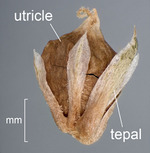 . Pericarp white, leatheryleathery:
. Pericarp white, leatheryleathery:
texture—moderately thick, tough, and very pliable
, glabrousglabrous:
without hairs
, smooth. Mesocarp fleshy.
Seeds oblongoblong:
2D shape—much longer than broad with nearly parallel sides, corners are rounded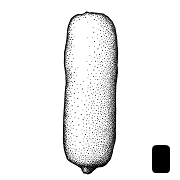 to ellipsoidellipsoid:
to ellipsoidellipsoid:
3D shape—elliptic
, triangulartriangular:
2D shape—three relatively straight sides with distinct corners; more angular than teardrop-shaped in transection, 1.5–4 mm long. Seed coat light brown without mottling or spotting, smooth and bristlybristly:
in transection, 1.5–4 mm long. Seed coat light brown without mottling or spotting, smooth and bristlybristly:
having bristles or stiff hair or hair-like structures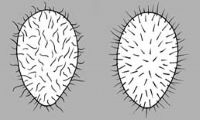 (A. gramineus) or with small pits or depressions (A. calamus).
(A. gramineus) or with small pits or depressions (A. calamus).
Embryo conical (A. gramineus) or linearlinear:
(shape) long, narrow, and uniform in width; (of embryo) embryo is straight and much longer than wide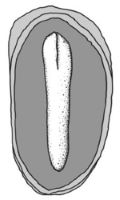 (A. calamus), straight, green.
(A. calamus), straight, green.
Endosperm copious; perisperm present.
Weedy in wetlands or along streams with aggressive spreading by rhizome.
Aquarium & Pond Plants of the World tool includes a description and images of Acorus.
| Fruit | |
| Type | berryberry: an indehiscent, fleshy fruit with one or a few to many seeds. The flesh may be homogenous throughout. Or, if the outer part is hard, firm, or leathery, referred to as an hesperidium. Septa are present in some, and the seeds may be arillate or with a fleshy testa.  |
| Size range | 4–6 mm long |
| Shape(s) | oblongoblong: 2D shape—much longer than broad with nearly parallel sides, corners are rounded  , ovoidovoid: , ovoidovoid:3D shape—ovate 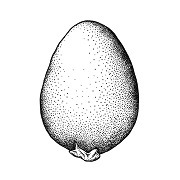 , cuneiformcuneiform: , cuneiformcuneiform:wedge-shaped , trigonoustrigonous: 3D shape—having three faces that meet at distinct angles; triangular in outline |
| Texture | epicarp–leathery; mesocarp–fleshy |
| Surface relief | smooth |
| Color(s) | white or brown |
| Unique features | Small fleshy berriesberry: an indehiscent, fleshy fruit with one or a few to many seeds. The flesh may be homogenous throughout. Or, if the outer part is hard, firm, or leathery, referred to as an hesperidium. Septa are present in some, and the seeds may be arillate or with a fleshy testa.  with persistent tepalstepal: with persistent tepalstepal:a member of the perianth, when it cannot be differentiated into a calyx and corolla  at maturity. at maturity. |
| Seed | |
| Size range | 1.5–4 mm long |
| Shape(s) | oblongoblong: 2D shape—much longer than broad with nearly parallel sides, corners are rounded  , ellipsoidellipsoid: , ellipsoidellipsoid:3D shape—elliptic , ovoidovoid: 3D shape—ovate  |
| Surface relief | smooth, pittedpitted: surface relief—surface with small depressions in which the areas between the hollows do not take on the appearance of a true reticular net  , punctatepunctate: , punctatepunctate:surface relief—dotted with pits or with translucent, sunken glands or with colored dots, similar to pitted 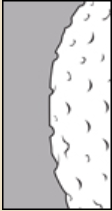 |
| Color(s) | brown |
| Unique features | Seeds glabrousglabrous: without hairs in A. calamus and bristlybristly: having bristles or stiff hair or hair-like structures  in A. gramineus. in A. gramineus. |
| Other | |
| Embryo | conicalconical: 3D shape—cone-shaped, with the point of attachment at the broad end 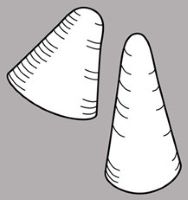 or linearlinear: or linearlinear:(shape) long, narrow, and uniform in width; (of embryo) embryo is straight and much longer than wide  , straight, green, partially fills seed coat , straight, green, partially fills seed coat |
| Nutritive tissue | copious perispermperisperm: seed nutritive tissue comparable to the endosperm, but derived from the nucellus (maternal tissue) and endosperm |
Temperate Northern Hemisphere (North America, Europe, Northern and Central Asia) and tropical Indo-Malaysia.
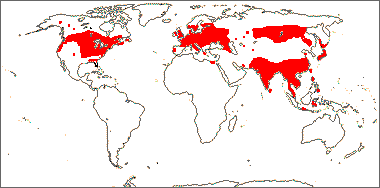
Distribution map courtesy of Angiosperm Phylogeny Website.
Baskin and Baskin 2021Baskin and Baskin 2021:
Baskin C and Baskin J. 2021. Relationship of the lateral embryo (in grasses) to other monocot embryos: A status up-grade. Seed Science Research 31 (3): 199-210. doi:10.1017/S0960258521000209; Bogner 2011Bogner 2011:
Bogner J. 2011. Acoraceae. Flora Malesiana 20: 1-13.; Dahlgren et al. 1985Dahlgren et al. 1985:
Dahlgren RMT, Clifford HT, and Yeo PF. 1985. The families of the monocotyledons: structure, evolution, and taxonomy. Springer-Verlag, Berlin. 520 pp.; Flora of Australia 2021+Flora of Australia 2021+:
Flora of Australia. Australian Biological Resources Study, Canberra. Accessed January 2021–March 2024. URL: http://www.ausflora.org.au; Flora of North America Editorial Committee 1993+Flora of North America Editorial Committee 1993+:
Flora of North America Editorial Committee, eds. 1993+. Flora of North America North of Mexico [Online]. 22+ vols. Flora of North America Association, New York and Oxford. Accessed January-March 2024. URL: http://beta.floranorthamerica.org.; Kirkbride et al. 2006Kirkbride et al. 2006:
Kirkbride JH, Jr, Gunn CR, and Dallwitz MJ. 2006. Family guide for fruits and seeds, vers. 1.0. Accessed September 2020-January 2022. URL: https://nt.ars-grin.gov/seedsfruits/keys/frsdfam/index.cfm .; Kubitzki et al. 1990+Kubitzki et al. 1990+:
Kubitzki K et al., eds. 1990+. The families and genera of vascular plants. 7+ vols. Berlin etc.; Le and Xu 2017Le and Xu 2017:
Le C and Xu Z. 2017. Identication and control of common weeds: Volume 3. Springer Nature, Singapore. 944 pp.; Takhtajan 2009Takhtajan 2009:
Takhtajan A. 2009. Flowering plants: Second edition. Springer Nature, Switzerland. 871 pp.; Zhengyi et al. 2004+Zhengyi et al. 2004+:
Zhengyi W, Raven PH, and Deyuan H. 2004+. Flora of China [online]. 25 vols. Science Press, Beijing China & Missouri Botanical Garden, St. Louis USA. Accessed January–March 2024. http://flora.huh.harvard.edu/china/
*The number of genera and species is based on Christenhusz and Byng 2016Christenhusz and Byng 2016:
Christenhusz MJM and Byng JW. 2016. The number of known plant species in the world and its annual increase. Phytotaxa 261 (3): 201-217. https://doi.org/10.11646/phytotaxa.261.3.1, which may differ from the number of genera in GRIN-Global.